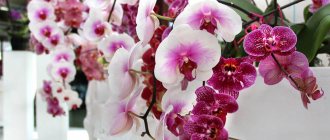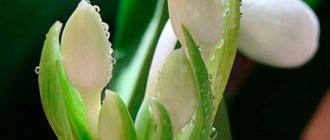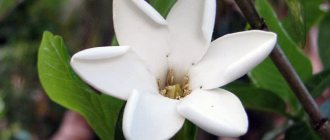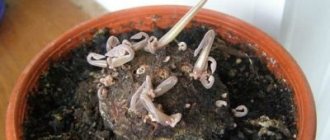Lush and long-lasting flowering depends on the living conditions in the apartment. They should be as close as possible to natural for this type of orchid. The frequency and duration of flowering depend on the variety and age of the orchid, lighting, humidity, and temperature. The article provides information about the periods and methods of stimulation, and describes the characteristics of the flowering of Phalaenopsis and Cattleya. It is described how to create favorable conditions during flowering and during the dormant period. The pros and cons of pruning the flower stalk are presented. The reasons for the withering and dropping of buds and flowers are indicated.
Frequency and duration
An orchid first blooms at 2-4 years of age, seedlings at 4-5 years. The number of formed leaves for the release of a peduncle is 5-8 pieces. The time during which an orchid blooms depends on the plant variety, growing conditions and care.
Usually the plant blooms once a year, for a period from several weeks to 3, 5, sometimes 8 months . Under natural conditions, flowering occurs during the dry summer season. In the northern hemisphere, this period corresponds to winter. In the natural environment, when the plant has flowered, the wind carries the seeds over a distance of several kilometers.
One peduncle, if not cut off, may bloom again. During this period, the orchid is intensively watered and fertilizing is used: succinic acid, vitamins in capsules, store-bought and home-prepared fertilizers.
An orchid at home is capable of flowering until it reaches the age of 10 years. Some varieties stop blooming after reaching 3 years. With improper care, the period is reduced, but under optimal, close to natural conditions, it increases. One flower blooms for 3-4 weeks. Full disclosure occurs within 24 hours.
Flowering period depending on the type of orchid:
- Cymbidium . October – February (in some sources – March), or from March to September. The peduncle is tied to supports, watering is reduced, and fertilizers are eliminated. Favorable temperature: 16-180C.
- Miltonia ("Butterfly Wings", "Pansies"), Miltassia . They bloom from March to June. Duration is 5-6 weeks. The temperature during the flowering period should be 18-220C.
- Dendrobium , Cymbidium . They bloom from early October to January (in some sources until the end of winter), sometimes in summer. Flowers - white, white-pink, crimson, lilac with a yellow center, lilac. To stimulate flowering, place the plant in a bright, cool place and stop watering.
- Oncidium blooms from April to July. Sometimes again - at the end of autumn, with a frequency of 1 time every 8-12 months. It may happen more often as the shoots develop.
- Paphiopedilum (“Slippers”, “Venus’s slipper”). The flowering period is from October to March. The rest period is not expressed. Good lighting and sufficient watering are provided throughout the year. In nature, this species is adapted to a lack of light (at the same time, Paphiopedilums are not shade-loving!) and high soil moisture.
- Odontoglossum . Flowering - late winter - early summer, for 2-3 months.
- Zygopetalum blooms from November to February, once or twice a year. Flowers in shades of green, brown, white and purple with spots and streaks.
Other conditions on which the period and duration of flowering depend:
- lighting,
- humidity,
- temperature.
The plant is replanted every two to three years. Signals for transplantation :
- Aerial roots have little space in the flowerpot and are located very close to each other. Perhaps they began to rot (due to too much compaction of the soil).
- Leaves, buds, and flowers turn yellow and wither. Occurs due to insufficient nutrition of the orchid through the roots on a dense substrate.
- Insects in the soil. The plant is taken out of the pot, the roots are washed in warm water, the pot and soil are changed.
- Viral, bacterial, fungal diseases. The roots are washed, the diseased parts are cut off, the sections are sprinkled with charcoal, cinnamon, and treated with hydrogen peroxide. The flowerpot and soil are changed.
After this, the orchid needs time to adapt, which takes up to 3 years. During this period the plant does not bloom.
Phalaenopsis
Flowering duration is from 2 to 8 months , beginning in December (in some sources - in January). Blooms up to three times during the year. 2-40 inflorescences of snow-white, dark scarlet, yellow and red shades are formed. Sometimes the color is blue. Flowers last up to 4 months.
Long flowering does not always have a positive effect on Phalaenopsis. Young and old plants that bloom for more than 3 months will use up all their strength, which will lead to the death of the orchid. The same applies to recently recovered and transplanted plants.
So, in order to interrupt unwanted prolonged flowering, the peduncle is carefully trimmed. The cut area is treated with cinnamon, charcoal or hydrogen peroxide. The plant is not watered for 2 days. The dried stump is covered with wax to prevent the penetration of bacteria and rotting. Fertilizer is applied to maintain the strength of the orchid.
Unlike Cattleya, Phalaenopsis lacks pseudobulbs and rhizomes, but has many aerial roots. The light must be diffused (Cattleya requires more light, including direct sunlight in the morning and evening - in summer, throughout the day - in cloudy weather and in winter).
To lay the buds of the peduncle, a dormant period of one to two months is organized. The temperature should be 160C. When buds appear, make sure that the temperature does not drop below 160C. If there is not enough light or the temperature is low, the buds will fall off.
The correct light and temperature can be ensured by moving Phalaenopsis to a balcony or loggia in the summer. The plant must be shaded from aggressive sunlight.
Important! An orchid can die in direct sunlight and in a draft.
A period of rest is required for Phalaenopsis. The plant rests and gains strength for the next flowering.
Interesting! The end of the dormant period is determined by the color of the root system. Uniform coloring means that the plant is dormant, green tips signal that the orchid is growing. Watering during this period is increased.
Cattleya
Flowering period - mid-spring - early winter, throughout the year. Duration – 4 weeks. If an orchid has 3 or more pseudobulbs, it blooms once every 8 months, with a dormant period. The development of a peduncle from a bud can take up to 4 months. The buds open sequentially. When the Cattleya orchid has bloomed, a period of dormancy begins. Reduce the intensity of watering and stop fertilizing.
Cattleya requires the following conditions for normal growth, development and, of course, flowering:
- The difference between day and night temperatures is 5-70C. In summer 22-280C during the day and 170C at night. In winter, 16-180C during the day and not lower than 120C at night. In the morning and evening, the plants are placed in the sun for several hours. Be careful: too aggressive sun causes burns.
- In the warm season, the pot with Cattleya is placed in a tray with water or wet pebbles. The water used is soft (settled, filtered or melted), lukewarm or at room temperature. Dive time – 10 minutes. This will ensure that many new aerial roots are produced.
- Water the substrate directly, avoiding water getting on the leaves and flowers of the plant. If a few drops get on the leaves or in the axils, dry with a napkin. Otherwise, brown spots will form where the liquid gets in.
- Feed the orchid, alternating with watering: watering - watering + feeding - watering, until a cover is formed at the base of the leaf. Then they stop fertilizing and start again when a bud appears.
Conventionally, Cattleya orchids are divided into two groups: those that bloom in spring and autumn. For autumn plants, the release of peduncles will be stimulated by a reduction in daylight hours. For spring, on the contrary, it increases.
Possible problems and useful tips for solving:
- The flower stalk is drying up. Insufficient watering, lighting or fertilizing.
- The leaves and pseudobulbs have become yellowish - there is too much light. If the leaves are a rich dark green color, there is not enough lighting.
Cattleya orchid
Cattleya, like other species and varieties of orchids, is susceptible to diseases and parasite attacks. The plant is periodically inspected, paying attention to the back of the leaves, stems, and substrate. If signs of pests appear, yellowing (blackening) of roots, falling leaves, buds and flowers, take action, otherwise the plant will die. A sick orchid must be isolated from other indoor plants.
How long does an orchid bloom at home?
Originally from tropical forests, orchids are real decorations of gardens, rooms and greenhouses. Under natural conditions, they grow on trees, less often on rocks and stone slabs, which, in combination with tropical climatic zones and humidity levels, allows them to remain active all year round, replacing one flowering phase with another.
Unfortunately, in the decorative environment everything is not so simple. Proper care of the orchid and proper attention to these flowers bear fruit. Orchids bloom, but not always for a long period. This depends on the type of orchid representative and the living conditions created.
In this article we will talk about how long an orchid blooms at home, and also discuss how many times a year and when representatives of the orchid family delight their owners with color.
Rest period
The life cycle of an orchid consists of five phases:
- Vegetation. It is characterized by the active development of the root system and the appearance of new shoots.
- Peace. The formation of buds and the growth of the peduncle occurs.
- Bloom. The buds grow and bloom. The plant uses maximum energy.
- Rest. Comes after flowering. The plant is sleeping and gaining strength.
- Active vegetation. If you properly care for an orchid, it ends in flowering.
Recommendations for creating favorable conditions during the rest period:
- The difference between day and night temperatures is at least 5 degrees. In such conditions, buds for flower stalks are formed.
- Fertilizers. The plant is fed with phosphorus, potassium, and microelements. Nitrogen promotes the growth of green mass, limiting the possibility of flowering. When the peduncle appears, stop applying fertilizer.
- Watering is reduced or replaced by spraying the substrate.
If a transplant is necessary, it is done during the dormant period. The soil can be purchased or home-made.
General provisions
So, let's look at how many and how some of the most popular types of orchids bloom.
- Dendrobiums and Cattleya. These orchids bloom up to 3 times a year, and their flower stalks are viable for 2 weeks.
- Miltonia blooms depending on how suitable the created regimes are for this. Its flowers can delight the owner for a long period of time. They usually bloom in the mid-season period of the year.
- Orchid Cambria and Cymbidium. These orchids bloom for 3 months a year. The flowering period depends on the conditions and time of year. But these are unpretentious species, so they bloom more often, without requiring enormous care efforts.
- Paphiopedilums, being a huge family, are united in a very long flowering period - up to 2 years. In this species, a period of rest must be observed.
- Phalaenopsis and its hybrids can bloom from several months to a whole year, branching their flower stalks and sending out new ones.
Creating favorable conditions for the release of peduncles
Location is the main factor contributing to the growth and flowering of a healthy orchid. The best place is the windowsill. In summer, the plant is taken out onto the balcony. Main rules:
- No drafts. Orchids love fresh air, but not drafts.
- Lots of light. As a tropical plant, orchids require good 12-hour light. From direct sunlight, the flower is shaded with blinds, a sheet of paper, or a cloth. In winter, phytolamps are used for illumination. The main thing is that the orchid does not heat up, so it is better not to use incandescent light bulbs.
Important! The roots must have access to light. Therefore, it is recommended to plant the orchid in a transparent flowerpot.
- High humidity (from 60%). An air humidifier, moistened expanded clay, and containers with water are placed next to the pot. In addition, the plant is sprayed (avoiding buds, flowers and leaf axils). Water about once a week. The water from the pan is drained to avoid rotting of the roots.
- Permanent location. The orchid does not like rearrangements - it is stressful for her.
Interesting! Many gardeners say that rearranging the pot does not affect the growth and development of the orchid.
- Suitable substrate. It is a mixture of moss, bark, and coal. A little peat, pebbles and shells may be added. You can purchase the substrate in the store or make it yourself.
Important! When preparing soil at home, all ingredients are sterilized. In nature, bark and moss contain pests and bacteria that cause diseases of orchids.
- Transparent pot with drainage holes. The condition of an orchid's roots is an important point for its growth, development and flowering. A flowerpot with transparent walls will allow you to monitor the condition of the root system and notice deviations in time.
Peculiarities
Experts note the following features of the flowering of this plant:
- the orchid blooms for the first time after reaching the age of two;
- if the plant was received from a child, you will need to wait until 6 airy petals form;
- the orchid needs adaptation and a calm state, i.e. There is no point in moving the pot from place to place.
Sometimes the conditions for keeping an orchid are so good that the flower puts all its energy into developing its leaves and root system. In this case, experienced gardeners recommend “scaring” the orchid - moving the pot to a cooler place or reducing watering to a minimum. Such a shock stimulates the plant to flower.
Stimulating and prolonging flowering
If the plant is healthy and strong, but instead of flowering it continues to grow green mass, create appropriate conditions and use one of the methods of stimulation.
- Lighting for at least 12 hours. If necessary, lighting with lamps. The light is scattered.
- Temperature without sudden changes. The difference between day and night temperatures should be 5-70C. The blooming orchid is provided with cool conditions.
- More frequent watering.
- Feeding with potassium and phosphorus.
Stimulation methods:
- Stressful situation . Watering is reduced, lighting is reduced and the temperature is slightly reduced. Wait for the soil to dry. Water after another 5-7 days. They don't fertilize. The temperature should not exceed 300C.
Note! Some Cattleya varieties will not bloom in low light conditions.
- Cytokinin paste. Select one dormant bud and remove its scales. Proceed carefully using a sharp knife. All scales are removed with tweezers. Apply the paste to the exposed bud with a toothpick.
Important! In order not to deplete the orchid, only one bud is treated.
- Garlic water. An excellent natural flowering stimulator. There are many recipes. For example, chop 1 clove of garlic, pour in 500 ml of boiling water, close the lid tightly and leave in a dark place for an hour. The solution is filtered and watered over the orchid. The liquid remaining in the pan after irrigation is drained. Frequency of use: water the plant once with plain water, once with garlic tincture. Using this method will allow you to get a new peduncle within 2 weeks.
Important! Do not let the garlic solution get on the buds, otherwise the orchid will drop them.
- Succinic acid . Dissolve 1 tablet of acid in 500 ml of hot water (or 2 grams of powder in 1 liter of water). The plant is watered and sprayed.
For reference! Prepare a mixture of garlic tincture and succinic acid. Water the orchid with the solution.
- Daily treatment with Epin . Dilute 1-2 drops in a liter of boiled water and spray the plant in the dark.
- Trimming the peduncle at a distance of several centimeters after the first dormant bud. The procedure is carried out with a sterile sharp instrument, preferably a knife.
- Purchased product " Bud ". Dilute 1.5 g. for 1 liter of water. Water or spray the plant.
- " Plumen ". Spray the orchid with 1 g dissolved in 500 ml of water. facilities.
- " Ovary ". Spray with solution in the morning or evening. The drug is prepared according to the instructions.
- Other preparations that stimulate the release of peduncles and the opening of buds: “Agrecol for orchids”, “Biopon for orchids”, “Clean sheet for orchids”, “Flower paradise orchid”, “Bona Forte for orchids”.
Following the following rules will help extend the flowering period:
- Do not change the location of the orchid.
- Do not replant (except in emergency cases: diseases and parasites).
- Do not fertilize or fertilize when the flowers have opened. If you continue to fertilize, flowering will quickly end. In addition, the root system can get burned.
- Water every 3-4 days. You can take a shower (water temperature is not lower than 350C).
Peduncle cutting: pros and cons
The opinions of flower growers are divided: some recommend be sure to trim the peduncle after flowering, others are categorically against it. It all depends on the type of orchid and the specific situation. For example, in Phalaenopsis it is recommended to trim the flower stalk immediately after flowering. But there is an exception here too. If the arrow remains green, then new buds will appear on it. When parts of the peduncle dry, only this part is cut off.
In Cattleya, the peduncle is left until it dries completely. The orchid takes nutrients from the shoot, and cutting it off is not only undesirable, but will also harm the plant.
Pros and Cons :
- Buds form on the dried peduncle and bloom again.
- Improper pruning and the use of blunt and unsterile instruments cause infectious diseases of the plant.
Pros : _
- Repeated flowering after a short time can destroy the plant, which does not have time to recover.
- A peduncle shoot (especially a dried one) looks ugly and not aesthetically pleasing.
Orchid lovers decide for themselves whether or not to trim the peduncle. None of the options will harm the plant.
Reasons for orchid buds and flowers falling off, what to do
Orchid age . A plant that is more than 5 years old will produce a flower stalk, but the buds will fall off. In this case, nothing can be done.
With excessive watering, the root system rots, which leads to the shedding of flowers and leaves. The same thing happens due to stressful situations: sudden changes in temperature, location, lighting, humidity.
Interesting! The orchid does not like proximity to apples, bananas, nuts, and tomatoes. The substances released by these products and plants negatively affect the condition of the flower.
The orchid loves fresh air, but has a negative attitude towards drafts (both cold and hot). Thus, ventilation of the room with the plant is very important. But! Protect the flower from air currents.
At very high or low temperatures, the plant drops buds and flowers and may die. When transporting home from the store, the orchid is carefully packed in paper and cellophane. The plant is not left on the balcony in winter. During the heating season, the radiator under the windowsill on which the orchid pot stands is covered with a towel. In addition, the leaves of the plant should not touch the glass to avoid freezing.
Orchid roots are delicate and easy to damage. For example, during a transplant. If this happens, sprinkle the damaged areas with ground cinnamon, crushed coal, and hydrogen peroxide.
The substrate becomes compacted over time, causing the water in the pot to stagnate and oxygen and nutrients not reaching the orchid roots. Therefore, the plant is transplanted into fresh soil every 2-3 years.
The plant is susceptible to viral, fungal, bacterial diseases, and pests. The orchid reacts by wilting leaves, rotting roots, and falling flowers and buds. If signs of any of the above conditions are detected, the orchid is isolated from other house flowers and immediate efforts to save the plant begin.











